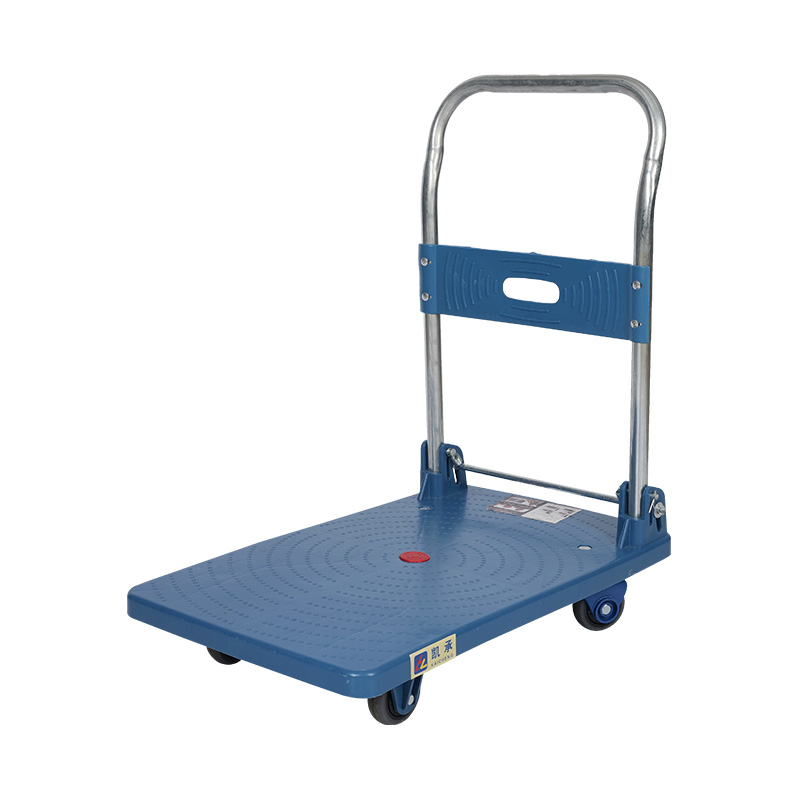There is a close relationship between the load-bearing capacity of One-Click Folding Hand Carts and its structural design. The load-bearing capacity is an important indicator for measuring the performance and safety of the cart, and its structural design directly affects the stability, durability and load-bearing capacity of the cart. The following are some key relationships between structural design and load-bearing capacity:
1. Frame material and load-bearing capacity
Material selection: The frame material of the cart is crucial to its load-bearing capacity. Common frame materials include aluminum alloy, stainless steel and high-strength plastic. Aluminum alloy is often used in folding carts because of its lightness, high strength and corrosion resistance. Choosing the right high-strength material can enable the cart to carry more weight while ensuring its lightness after folding.
Structural reinforcement: Whether the frame design of the cart adopts a reinforced structure (such as cross support, thickened pipe, etc.) will also significantly affect the load-bearing capacity. Reasonable structural reinforcement can prevent bending or deformation when carrying heavier items.
2. Wheel design and load-bearing capacity
Wheel size and material: The size and material of the wheel directly affect the load-bearing capacity and driving stability. Large wheels can disperse the load and reduce the pressure on each wheel, so they have a higher load-bearing capacity. In addition, the choice of wheel material (such as rubber, polyurethane, plastic, etc.) will also affect its load-bearing capacity and wear resistance when driving on different surfaces.
Number and layout of wheels: One-touch folding trolleys are usually equipped with two or four wheels. The four-wheel design usually provides greater stability and is suitable for trolleys with high loads, while the two-wheel design is more suitable for lightweight and easy-to-carry trolleys. Reasonable wheel layout (such as the distribution position of the wheels, the load-bearing axis, etc.) can help share the weight and improve the load-bearing capacity.
3. Folding mechanism and load-bearing capacity
The impact of folding structure: The one-touch folding mechanism is one of the key designs of the trolley, which determines the folding convenience and load-bearing stability of the trolley. The folding structure must be designed so that it does not affect the strength of the frame when folded, and can quickly lock each component when unfolded to ensure that the load-bearing capacity is not affected by the folding mechanism. If the folding design is unreasonable, it may cause the structure to loosen and affect the load-bearing capacity.
Locking system: After unfolding, the folding mechanism must have a reliable locking system to prevent the trolley from folding or loosening suddenly when in use, so as to ensure that the load-bearing capacity will not be reduced due to structural instability. A well-designed locking system can maintain the rigidity of the entire body, thereby ensuring a higher load capacity.

4. Chassis design and load-bearing capacity
Chassis support design: The chassis design of the trolley determines the stability and support of the items. The width, thickness and position of the load-bearing parts of the chassis determine whether the trolley can evenly distribute the load. A wide and sturdy chassis can provide better support and reduce the risk of tilting or tipping when carrying heavy objects.
Distribution of support structure: The design of the support points of the chassis and frame is also directly related to the load-bearing capacity. For example, multiple support points can ensure that all parts are evenly stressed when carrying weight, avoiding excessive pressure on a certain part and causing damage.
5. Handle design and load-bearing capacity
Handle material and structure: The design of the handle directly affects the stability and comfort of the user when operating the trolley. If the handle design is too weak or not firm, it may lead to uneven load during use, or even the handle falling off, thus affecting the overall load-bearing capacity.
Handle height and angle: The height and angle of the handle should be ergonomic to avoid excessive tilt angles that cause uneven force distribution during use and affect the stability of the trolley. Reasonable handle design allows users to apply force evenly when carrying heavy objects, reducing the pressure on the trolley structure.
6. Safety considerations in design
Anti-overturning design: When carrying heavier objects, the trolley may be at risk of overturning, especially under higher loads. To avoid this problem, the design needs to consider the low center of gravity design so that the load of the trolley is as close to the ground as possible to reduce the risk of overturning.
Enhanced stability: In addition to the low center of gravity, the stability of the trolley can be increased by designing some additional support legs, anti-tilt devices or reinforced support points, especially when carrying large or irregular objects, which can improve the overall load-bearing capacity.
7. Adaptability to the use environment and carrying capacity
Versatile design: Some one-touch folding trolleys are designed with detachable or adjustable parts to adapt to different types of loads. For example, by designing adjustable support frames or modular accessories, support points can be added when carrying larger items, thereby improving the overall carrying capacity.
Adaptability to special environments: When used in harsh environments (such as high temperature, low temperature, humidity, etc.), the material and structural design of the trolley also need to take into account characteristics such as corrosion resistance and high temperature resistance. Good material selection and reasonable design can ensure that the trolley can still maintain a stable carrying capacity in these environments.
There is a close connection between the carrying capacity of a One-Click Folding Hand Carts and its structural design. Factors such as material selection, frame design, wheel configuration, folding mechanism, chassis design, and handle design all directly affect the carrying capacity of the trolley. Through reasonable design, the carrying capacity and durability of the trolley can be improved while ensuring the convenience and lightness of folding, so that it can adapt to different usage needs and environments.


 English
English Español
Español



